 Image search results - "ninja" Image search results - "ninja" |

Ueno-shi Station has ninja dolls to greet you.
|
|

Even the trains have a ninja (female) paint job.
|
|

Ninja paint job on a train.
|
|

Iga-Ueno really plays up its ninja past.
|
|

Iga-ryu Ninja House is in Ueno Park which includes Iga-Ueno Castle nearby.
|
|

Iga-ryu Ninja House is a thatched-roof house whose roof once caught fire in the 1990s. It was rebuilt.
|
|

Iga-ryu Ninja House garden. They take you in groups, so you may have to wait a while before you can go in.
|
|

Once a group gets large enough, they take you all in and a female ninja guide explains the house's ninja trickery. Admission charged. Recommended is the set of tickets that admit you to the ninja house, castle, and Danjiri Museum.
|
|

The first demo is this swinging wall.
|
|

Lets you escape to the next room instantly, or climb up or down the ladder on the right wall.
|
|

This is a staircase concealed as a shelf.
|
|

Now a shelf. It leads to the attic.
|
|

Another wall door that leads to the basement tunnel.
|
|

Entrance to the basement.
|
|

Another swinging wall door.
|
|

Inside the Iga-ryu Ninja House.
|
|

Emergency escape hatch whose lock can be quickly released with a sheet of paper.
|
|

There she goes.
|
|

Hidden floor compartment where they hid their valuables outside the house.
|
|

When you push in the end of this floor plank, it opens up to reveal a sword.
|
|

Sword hidden in the floor.
|
|
|

Kunoichi female ninja guide
|
|

Inside the Iga-ryu Ninja House
|
|

An altar in the Iga-ryu Ninja House.
|
|
|
|

Kitchen area in Iga-ryu Ninja House.
|
|

Kitchen in Iga-ryu Ninja House.
|
|
|

Ninjas in the kitchen. We could not go up into the attic as we can in Koka's ninja house in Shiga.
|
|
|

Kitchen
|
|

Thatched-roof of Iga-ryu Ninja House.
|
|

Veranda of Iga-ryu Ninja House
|
|

Revolving door of Iga-ryu Ninja House
|
|

Iga-ryu Ninja Museum
|
|

Ninja disguises
|
|
|
|
|
|
|

Lock picks
|
|
|

Flipper-like clogs to walk through swamps
|
|
|

What would a ninja museum be without a display of shuriken?
|
|

Ninja swords are short and straight with no curvature.
|
|

For an extra 200 yen, you can watch the ninja show right next to the ninja house.
|
|

Iga-ryu Ninja House ninja show.
|
|

Sword demo
|
|
|
|
|

Shuruken takes skill to throw.
|
|
|

Juggling sickles. Having a sickle did not arouse suspicion as it was a common farming tool. But for the ninja, it was an effective weapon.
|
|

Throwing sickles and shuriken.
|
|
|

Duel to the death.
|
|

You have to applaud once in a while.
|
|

Shuriken throwing.
|
|

Nakayama Emiri, a TV personality, tries to throw shuriken.
|
|
|

Another ninja museum.
|
|

Inside ninja museum which is in a former rice warehouse.
|
|
|

Making medicine.
|
|

Ninja costumes
|
|

Five-colored rice grains used for secret communication.
|
|

Five-colored rice grains used for secret communication.
|
|

More secret ninja language.
|
|

Rope knots hung on roof eaves, etc., were also used for communication.
|
|
|
|
|

Ninja swords.
|
|

Iron claws
|
|

Bamboo sticks concealing a sword.
|
|

Pepper bombs to blind you.
|
|
|

Cushion
|
|

Iga-Ueno Ninja Festa poster
|
|

During April and early May, they hold the annual ninja festa.
|
|

See many people wearing ninja costumes during the ninja festa.
|
|

Where you can rent a ninja costume.
|
|

Ninjas under cherry blossoms.
|
|

Female ninja
|
|
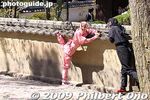
Female ninja climbing over a wall.
|
|

Even ninja get thirsty.
|
|

Ninja shop
|
|

Ninja doll on a pole.
|
|

Everywhere you go in Iga-Ueno, you see a ninja motif.
|
|
|

Storefront shutter with ninja drawings.
|
|
|
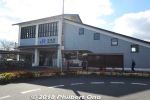
JR Koka Station on the JR Kusatsu Line opened its new station building in Nov. 2005. Resembling a farmer's warehouse on the outside, the inside has a number of surprises. MAPNorth side
|
|

JR Koka Station north (Kitaguchi) side.
|
|

Ninja statue in front of JR Koka Station, Shiga Prefecture.
|
|
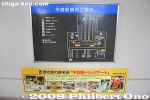
Map of Koka Station and a guide to the "Koka Station Trick Art." Seven wall murals of ninja paintings inside the station.
|
|
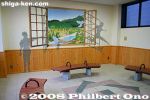
On the north side, the waiting room has this large painting. The shadow areas is where you can stand and pose for a picture.
|
|
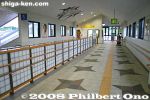
Koka Station's 2nd floor corridor has shuriken (ninja throwing knives) design on the floor.
|
|
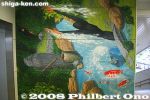
Wall mural sideways, showing ninja and a river.
|
|
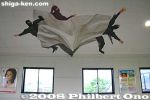
Ceiling painting of ninja appearing from a cloak. You can have someone "touch" the tip of the cloak.
|
|
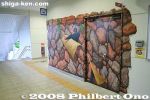
Near the turnstile entrance. These ninja wall murals are called "Trick Art." They look three-dimensional and you can interact with the paintings. You can pose within the painting itself. A brilliant idea. トリックアート
|
|
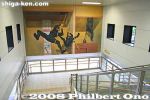
The stairway on the south side of Koka Station has this dramatic mural of ninja in action.
|
|
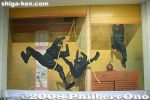
Ninja painting in Koka Station.
|
|
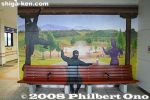
This painting uses a real bench where you can sit down and pose with the ninja. JR Koka Station on the JR Kusatsu Line, Shiga Prefecture.
|
|
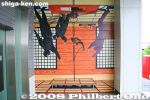
Suspended ninja in a painting next to the elevator. You supposed to sit on the floor and make like the ninja is coming after you.
|
|
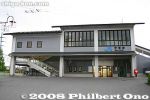
JR Koka Station, south entrance.
|
|
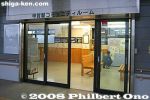
The south entrance has community room serving as an exhibiiton space. It also displays medicines made by Koka medicine makers. Many ninja families in Koka were medicine makers.
|
|
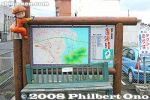
Sign on south side of Koka Station. There's a ninja character climbing up the sign, but the map does not show the ninja village or ninja house.
|
|

The old JR Koka Station (south side), photographed in 2004. It was a small station.
|
|

Koka Ninja House (Koka-ryu Ninjutsu Yashiki) is the former residence of Mochizuki Izumonokami, the leading Koga ninja family of the 53 Koka ninja families. 望月出雲守 MAPThe house is in its original location in the Koka area of Shiga Prefecture.
|
|

The Ninja House, built in 1703, is owned and maintained by a local medicine company having ninja roots. Many Koka ninja were makers of medicine as a front for their clandestine activities. This background also made them expert at making gunpowder.Not a National Historic Site, but it should be.
|
|

The Koka Ninja House is located 2 km from JR Konan Station on the JR Kusatsu Line. There are no buses going to the Ninja House. The house is open every day 9 am - 5 pm. Closed Dec. 27-Jan. 1. Admission is 600 yen for adults. 望月出雲守
|
|

The first room you see in the house is the living room. You can sit and have free "ninja tea" while waiting for a guided tour of the house. Along with the geisha, the ninja is one of the most recognized but misunderstood things about Japan.
|
|

The upper walls have explanations about the Koka ninja and Mochizuki ninja family. "Koka" is the correct pronunciation, but the kanji can also be pronounced "Koga" which has become more common.
|
|

Revolving door (opened). The floor also has a trap door (see next photo) where you can go down and escape through a tunnel leading to a well in the garden outside.
|
|

Trap door on the floor opened.
|
|

Inside the trap door is a hole and tunnel leading to a well in the garden outside. Hence the water.
|
|

Entrance to another room on the first floor. Although the Koga ninja and Iga ninja (in Mie Prefecture) were the most famous, there were actually numerous ninja groups in many other parts of Japan as well. They were most active during wars.
|
|

This room has display cases showing various ninja weapons, tools, and costumes. The ceiling is also quite low, designed to impede the wielding of samurai swords.
|
|

The left sliding wooden door is very heavy, about 50 kg, making it difficult to open. This buys more time for the ninja to escape.
|
|

Closet with a trap door on the floor.
|
|

Ladder going up to the attic.
|
|

Ladder going to the 2nd floor. There's also a trap door on the floor below the ladder where the ninja could hide. Notice the rope. The ninja hiding under the floor would tug the rope connected to the 2nd floor.
|
|

That rope goes to the second floor (see next photo).
|
|

The rope is connected to a noise maker on the 2nd floor here. The intruder would then think that the ninja is on the 2nd floor and go up the ladder in pursuit. When the intruder is on the 2nd floor, the ninja below the trap door would remove the ladder.
|
|

The 2nd floor, between the first floor and ceiling, has a very low height which can entrap an intruder going upstairs.
|
|

The wooden railing on the right is slimmer than the left one. It means it is removable, allowing the ninja to escape from the 2nd floor.
|
|

Ceiling of Ninja House. Directly below the thatched roof.
|
|

Ceiling of Ninja House.
|
|

Stairs to go back down to the 1st floor. There's a rotating door. Ninja worked behind the scenes and were very secretive. They hardly told others about their activites nor left written records. Sometimes they worked as spies or mole.
|
|

The veranda is another escape route after opening trick windows from the inside. Ninja avoided direct combat and preferred to defend themselves and escape from enemies. Assassination was only a minor part of their activities.
|
|

Small revolving door connected to a closet. The Koka ninja's main activity was gathering information. As they traveled and sold medicines, they always talked to people and their customers. They tried to find out how many guns the enemy had, etc.
|
|

Medicine ad sign reading Ninjutsu-gan. For belly aches. Although the ninja's medicine-making remains today, the art of ninjutsu is ironically no longer practiced in Koka. It is not a martial art like karate and judo.
|
|

For 500 yen, you can rent a ninja costume of various colors.
|
|

Little ninja at target practice.
|
|

The Koka Ninja House also has a Shuriken Dojo. Pay 200 yen for five shuriken throwing stars (300 yen for 10) and try hitting the bull's eye.
|
|

Real ninja obviously did not wear a pink costume, but in the manga/anime world, pink looks cute.
|
|

Trying my shuriken skills. You throw it with an overhand throw (like a baseball) and not like a frisbee. Also see my YouTube video here.
|
|

Three out of five of my shuriken at least stuck on the board. But all missed the target which is quite low. Probably geared for kids.
|
|

Real ninja shuriken throwing star knives on display. Made of steel, they come in many different shapes.
|
|

A flaming star
|
|

Maki-bishi spikes thrown on the ground to poke your feet. These are made from dried water chestnuts (aquatic plant found in marshes). One of the four spikes will point upward.
|
|

Maki-bishi made of steel. Used for escape when they encountered an enemy. Many of the ninja's weapons were designed to buy time for the ninja to escape.
|
|

Dart-shaped shuriken. Shuriken were not only star-shaped. These were either thrown straight-on, or thrown while the point rotated 180 degrees turning toward the target. It was difficult to throw, and much practice was required..
|
|

Ninja sword, very short.
|
|

Gunpowder case
|
|

Small gun concealed as a sword.
|
|

Bullets with various gauges.
|
|

The famed Bansenshukai Ninja Bible detailing ninja tools and techniques. This is a replica.
|
|

One room's upper walls display a chronological history of the Koga ninja.
|
|

Ninja tools
|
|

Display case showing ninja costumes. Real ninja mainly wore one of seven disguises instead of the stereotypical black costume. They could be dressed as a priest, merchant, jester, etc.
|
|

Contrary to popular belief, ninja cannot walk on water. "Mizugumo" means water spider. To move across water, they used a wooden floating ring shown here, and sat in the middle.
|
|

They wore wooden geta clogs with flippers which helped them propel themselves underwater. The wooden floating ring is collapsible and quite light. Almost like balsa.
|
|

A sketch shows how they were "water spiders." They were largely submerged in the water, with the wooden ring also submerged, but buoyant enough for them to float across while kicking through the water with the flipper clogs.
|
|

Straw ninja hat with a deep brim to hide their face. Dressing like a priest, merchant, etc., would arouse the least suspicion while they traveled.
|
|

Straw sandals with metal claws for traction.
|
|

Blow tube and blow darts.
|
|

Blow darts with poison tips maybe.
|
|

Metal finger claws worn on the fingertips.
|
|

Medicine (gunpowder?) case.
|
|

Swinging chain with weights on the ends. Wrap it around the opponent's neck.
|
|

The array of ninja weapons and tools was very impressive. This Ninja House strives to dispel some of the myths and misconceptions of the ninja. A visit is highly recommended.
|
|

Hooks for hoisting ropes on walls, etc. The Koka ninja reluctantly moved to Edo (Tokyo) around 1634 as requested by the shogun, and worked as castle guards, gathered intelligence on daimyo lords, and formed a gun battalion.
|
|

Manga cells. Ninja manga characters are famous. However, real ninja never became famous. Being famous in name or face would greatly decrease the value of that ninja.
|
|

Outside the ninja house. This ninja house is very impressive. It does have an air of authenticity, although there are, unavoidably, a few touristy elements. This house should be designated as a Important Cultural Property or an National Historic Site.
|
|

Wooden ad sign for aspirin.
|
|

Gift shop selling medicines, tea, and ninja goods.
|
|

Medicines made by the company which owns the house.
|
|

Healthy "Ninja tea." Free samples in the living room.
|
|

Ninja souvenirs
|
|

Ninja phone straps
|
|

Soft rubber shuriken (toys). Special thanks to Takayuki Mochizuki (ninja descendant) for taking me to this Koka Ninja House.
|
|

The Ninja House also displays autographs by celebrities who visited the house. This is actor Harrison Ford who visited in Feb. 2000. He came unannounced with a taxi driver, interpreter, and his son.
|
|

This is an autograph by Shiga Governor Kada Yukiko who visited the Ninja House on April 24, 2009. In red reads "Mottainai," her motto meaning "Wasteful," in reference to spending of tax dollars.
|
|
|

As a theme park, the Koka-no-Sato Ninjutsu-mura or Koka Ninja Village offers a good tourist sampling of ninja in a hidden village of former ninja houses transplanted to this "village." Entrance to Koka Ninja Village, tucked away in a hidden, lusEntrance to Koka Ninja Village, tucked away in a hidden, lush forest. Quite far from the nearest train station (Koka Station on the Kusatsu Line). You can call them from the train station to be picked up.
|
|

Path to Koka Ninjutsu-mura Village. Admission is 1,000 yen for adults. Cheaper for students. Open 10 am - 5 pm. Free shuttle bus available from JR Koka Station. Phone: 0748-88-5000
|
|

Shinobi Shrine is what you first see. Worships all the nameless ninja who died. The ninja never tried to gain fame. They remained unknown. 志能備神社
|
|

Shinobi Shrine has a statue of Daikokuten, one of the seven gods of good fortune. He is worshipped for good marriage, food, and prosperity. Made during the early Edo Period, it's Japan's largest wooden statue of Daikokuten. 大黒天
|
|

Path down to Koka Ninja Village. Lots of greenery. MAP
|
|

Monument for Sarutobi Sasuke, a famous Koga ninja who was born in Koka. However, he was only fictional character. Ninjas never tried to become famous. 猿飛佐助の碑
|
|

The Mizugumo Water Spider Pond where you can walk on water. A few visitors, wearing ninja costumes, try it out.
|
|

A pair of floating rings with a platform in the middle.
|
|

Grab the rope and step into the foot rings. Of course, ninja never wore a bright red costume. You can rent a ninja suit in various colors for 600 yen.
|
|

Whoa, almost fell into the water!
|
|

There he goes, not exactly walking on water. Just dragging himself across with the rope. This is only for anime-like amusement. This is not how the ninja did it.
|
|

Water spider (mizugumo): How the ninja did it. This drawing from the Koka Ninja House shows how it was done. The ninja sat on the board inside the wooden ring and waded through the water while partially submerged. His wooden clogs had small flippers.
|
|

The Ninja house (Ninja yashiki) is one of the main attractions of the Ninja Village. This was an actual ninja house belonging to the Fujibayashi ninja family. It was disassembled and transplanted here from Ohara Ichiba in Koka.
|
|

The Ninja house was built in 1842. There is a guide (dressed in ninja costume) inside to show you around.
|
|

Inside the ninja house. A hearth with a escape hatch at the bottom.
|
|

Hearth with a escape hatch at the bottom. A tour guide shows you the gimmicks of the house.
|
|

Trap door behind a scroll with the kanji "shinobi" (stealth).
|
|

Going through the trap door.
|
|

This entire ceiling was designed to fall down on any assailant in this room.
|
|

Ninja house attic showing the thatched roof.
|
|

Ninja well with an escape tunnel which you can almost walk through.
|
|

Next to the Ninja house is the Koka Ninja Museum (Koka Ninjutsu Hakubutsukan). This was also a fomer house transplanted here. 甲賀忍術博物館
|
|

Inside Koka Ninja Museum which opened in 1983. The dirt-floored room has various ninja ladders.
|
|

Koka Ninja Museum also has showcases with various ninja costumes, documents, weapons, etc. The museum is kind of rundown though.
|
|

Ninja's secret language. A codified system.
|
|

Map of Japan showing numerous ninja schools which existed during the feudal era. Iga-Ueno and Koga ninja were the most famous.
|
|

Ninja looked at a cat's eyes to find out what time it was. If the iris was almost closed, it was noon. If dilated, it was late at night. Must've been troublesome to find and snatch a cat to find out what time it was.
|
|

Ninja armored suit for protection against swords.
|
|

Shuriken throwing knives.
|
|

Shuriken throwing knives.
|
|

Tools for making medicine (including gunpowder). Many Koka (Koga) ninja were medicine makers. It was a disguise and a means to gather information from people when they went around selling medicines. Koka ninja were always in contact with the local people.
|
|

Medicine packages from Koka ninja-related medicine companies. Even today, Koka has numerous medicine manufacturers.
|
|

Shuriken Dojo Hall 手裏剣道場
|
|

Shuriken Dojo has a few stalls. For a few hundred yen, you can throw real shuriken at wooden targets.
|
|

Shuriken target practice at the Shuriken Dojo in Koka Ninja Village, Shiga Prefecture. 手裏剣道場
|
|

Other activities.
|
|

Swinging down a rope.
|
|

Castle wall to climb on.
|
|

Wall to climb on
|
|

Shigaraki pottery lessons
|
|

Shigaraki tanuki racoon dogs.
|
|

Outdoor stage, where they hold events like the Miss Kunoichi Contest.
|
|

Giant Buddha's hand. Used in a 1982 ninja movie. The hand has the same scale as the Giant Buddha's hand in Nara's Todaiji temple.
|
|

Roof with ninja family crest.
|
|
|

Ninja costumes for sale. 10,000 yen for adult costume, and 7,000 yen for children's size.
|
|

Ninja dolls
|
|

Honolulu Advertiser newspaper from Hawaii featuring a photo of a ninja from Koka who performed at Ala Moana Shopping Center in 1990.
|
|

A ninja show performed by an Iga-ryu ninja trouope called Kurondo from Iga, Mie. 黒党
|
|
|
|
|
|
|

Ninja show
|
|
|
|